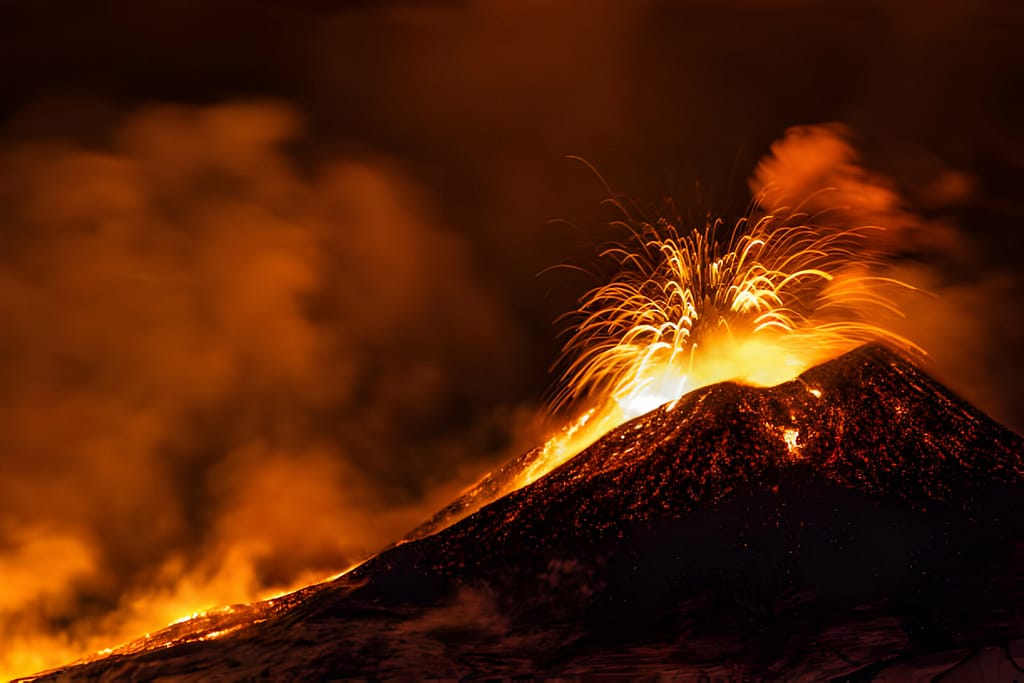Located on the eastern coast of Sicily in Italy, Mount Etna stands as a geological wonder in the heart of the Mediterranean Sea. This active stratovolcano is the tallest in Europe and one of the most active in the world, with a recorded history of eruptions dating back to 1500 BC. Its ever-changing landscape, from the lava flows to the snow-capped peak, has not only fascinated poets, explorers, and scientists for centuries but has also shaped the cultural and natural history of the surrounding region.
Table of Contents
Mount Etna Facts

Mount Etna is the tallest active volcano in Europe, standing at roughly 10,991 feet (3350 meters) above sea level. Its history is as rich and varied as the Sicilian landscape itself. The volcano has been erupting for millennia, with recorded eruptions dating back to at least 475 BC. These eruptions have ranged from minor lava flows to catastrophic events that have devastated nearby towns and villages.
One of the most famous eruptions occurred in 1669 when Mount Etna erupted from top to bottom, spewing millions of tons of lava and ash that buried the city of Catania and the surrounding countryside. Lesser eruptions have occurred before and since, including more than a dozen in the 20th century alone.
Mount Etna’s summit is not fixed; it changes over time due to repeated eruptions that cause the tops of volcanoes to cave in, leaving saucer-shaped depressions known as calderas. The volcano has had at least two summits before the present one, and there is a massive caldera on its side – a great hole 12 miles (20 kilometers) round, with sides dropping sheer for 3000 feet (900 meters).
Etna’s eruptions are thought to originate from a lava reservoir some 18 miles (30 kilometers) long by 2 1/2 miles (4 kilometers) deep, located below the mountain and fed by enormous quantities of gas-charged molten matter welling up from beneath the Earth’s crust. The pressure builds until it finally emerges on the surface as fountains of fire, clouds of sulfuric gas, and torrents of lava, pouring down the mountainside.
Mount Etna Legacy
Mount Etna’s legacy is not just one of destruction but also of creation. The volcano’s eruptions have enriched the soil, making it incredibly fertile. The surrounding landscape is dotted with vineyards, olive groves, and citrus orchards, all thriving in the nutrient-rich soil.
Despite the danger, people have been drawn to Mount Etna for centuries. The volcano’s slopes are home to charming villages, where life goes on amidst the ever-present threat of eruptions. The people of Sicily have learned to live with the volcano, adapting to its cycles of destruction and renewal.
For visitors, Mount Etna offers a unique opportunity to witness the power of nature up close. The volcano is a popular destination for hikers and climbers, who can ascend its slopes on foot and witness the natural history of the area unfurl before them. From the lush lower slopes, covered in vines, oranges, and pistachios, to the barren, ash-covered upper reaches, Mount Etna is a place of stark beauty and raw power.
As the sun rises over the Mediterranean, Mount Etna casts its shadow over the island of Sicily, a reminder of the forces that have shaped this land and its people. Whether you’re exploring its slopes or simply admiring its beauty from afar, Mount Etna is a place that will leave a lasting impression on anyone fortunate enough to experience it.